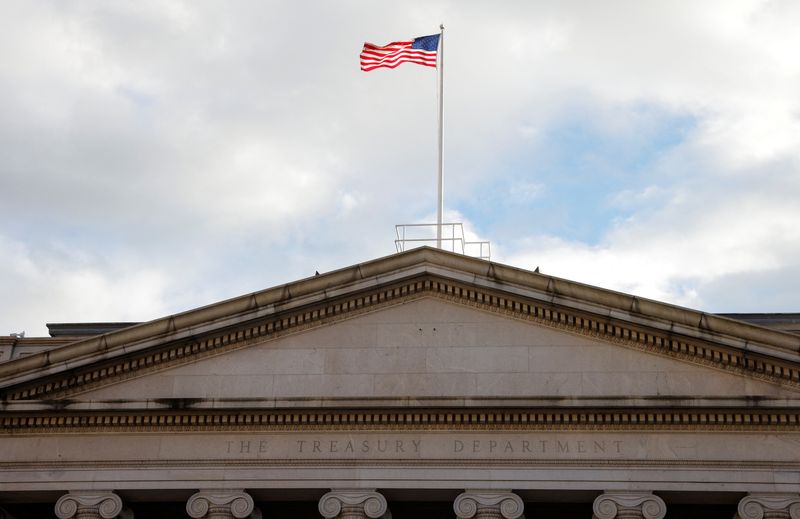WASHINGTON (Reuters) - As a battle between Republicans and Democrats over raising the federal debt ceiling unfolds, the U.S. Treasury has begun using extraordinary cash management measures to keep the U.S. government from breaching the $31.4 trillion borrowing limit.
The measures will allow the Treasury to claw back more than $500 billion in borrowing capacity, but it's unclear how long that will last beyond early June as tax revenues ease and outlays for debt service, healthcare and Social Security grow.
Here's a rundown of the Treasury's tools to keep borrowing under the limit.
GOVERNMENT SECURITIES INVESTMENT FUND
On Jan 24, the Treasury suspended daily reinvestments in a federal employee retirement fund known as the G Fund, which had a balance of $294 billion as of Dec. 31. Normally the money market-like fund reinvests its entire balance daily into special-issue Treasury securities that count against the debt limit, but the move allows the government to issue more normal Treasury bills, notes and bonds instead.
The fund must be made whole, including lost interest, when the debt ceiling is raised or suspended, protecting federal employees.
CIVIL SERVICE, POSTAL RETIREE FUNDS
The Treasury on Jan. 19 suspended investments in the Civil Service Retirement and Disability Fund and the Postal Service Retiree Health Benefit Fund -- except for amounts needed to pay benefits.
The suspensions allow Treasury to reclaim about $8.3 billion in borrowing capacity per month, or a total of $41.5 billion for the five-month "debt issuance suspension period" declared by Treasury Secretary Janet Yellen though June 5 -- a period that could be extended.
On June 30, the Treasury can regain another $143 billion in borrowing capacity when $131 billion in investments in the Civil Service Retirement and Disability Fund matures. A $12 billion interest payment to the fund also is due on that date. If Yellen extends the suspension period past June 30, the Treasury can suspend these investments and reclaim borrowing capacity in a one-time action that must be reversed once the borrowing limit is raised.
EXCHANGE STABILIZATION FUND
The Treasury could dip into this seldom-used $210 billion fund and suspend daily reinvestment of the dollar balance -- currently about $17 billion -- to free up borrowing headroom. Created during the Great Depression of the 1930s to stabilize dollar exchange rates, the fund was most recently used during the COVID-19 pandemic to backstop Federal Reserve emergency lending programs for businesses. The funds would need to be restored once the debt impasse ends, but not lost interest.
SUSPEND STATE, LOCAL GOVERNMENT SECURITIES
The Treasury can suspend sales of State and Local Government Series securities -- known as "slugs" -- which are special low-interest Treasury securities offered to state and local governments to temporarily invest proceeds from municipal bond sales. Slugs issues, which count against the debt limit, have recently averaged $6 billion per month, but monthly volumes vary. At that rate, a five-month suspension could conserve $30 billion in borrowing headroom.
These items were the only ones that the Treasury identified in a description of extraordinary measures, but the department also has employed and considered other tactics in the past:
ISSUE MORE CASH MANAGEMENT BILLS
The Treasury could cut issuance of longer-term government debt and rely more heavily on short-term cash management bills to gain more day-to-day control over debt outstanding. Cash management bills are typically issued for days instead of normal Treasury bill maturities of four weeks to one year. But this is unlikely to buy much time and officials have traditionally been wary of making major shifts in the Treasury's debt issuance calendar, which could upset markets.
SUSPEND SAVINGS BONDS
Treasury secretaries in the past have halted sales of U.S. savings bonds to the public during debt limit impasses, but it would not free up borrowing authority and would only prevent small amounts of new debt from being issued. Savings bond sales increased the federal debt by just $5.7 billion since the start of the 2023 fiscal year last October.
SWAP FEDERAL FINANCING BANK DEBT
The Federal Financing Bank can issue up to $15 billion in debt on behalf of other government agencies that is not subject to the debt limit. So the Treasury could exchange FFB debt for other debt to reduce the total amount subject to the limit. However, the measure would also create only a small amount of borrowing headroom. According to the bank's fiscal 2022 annual report, $4.8 billion worth of this capacity had already been utilized.

ASSET SALES
The Treasury could consider sales of U.S. gold or other holdings to pay bills, but department officials in the past have argued that this is unworkable, creating the specter of fire sales or destabilizing markets by reducing U.S. reserve assets.